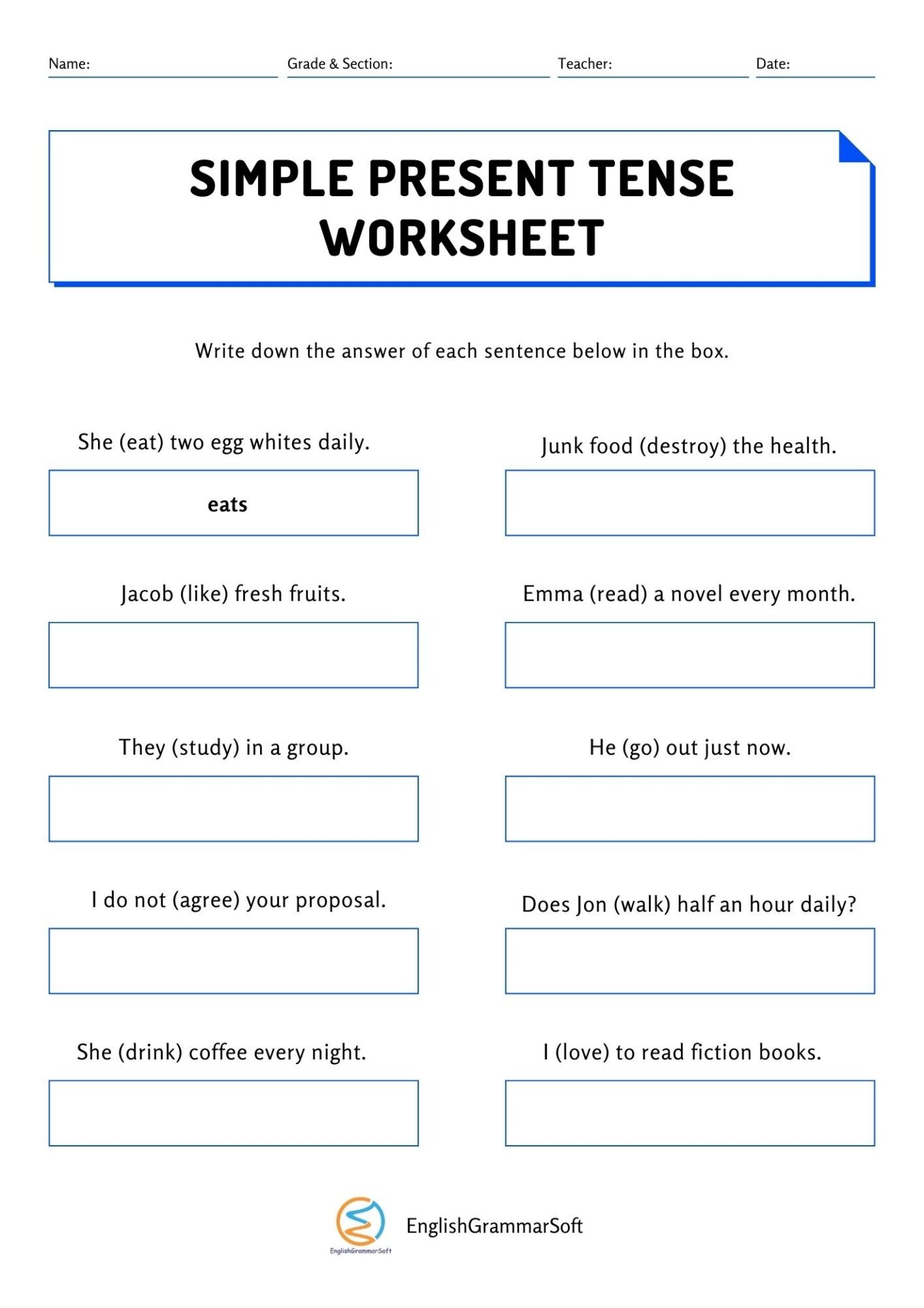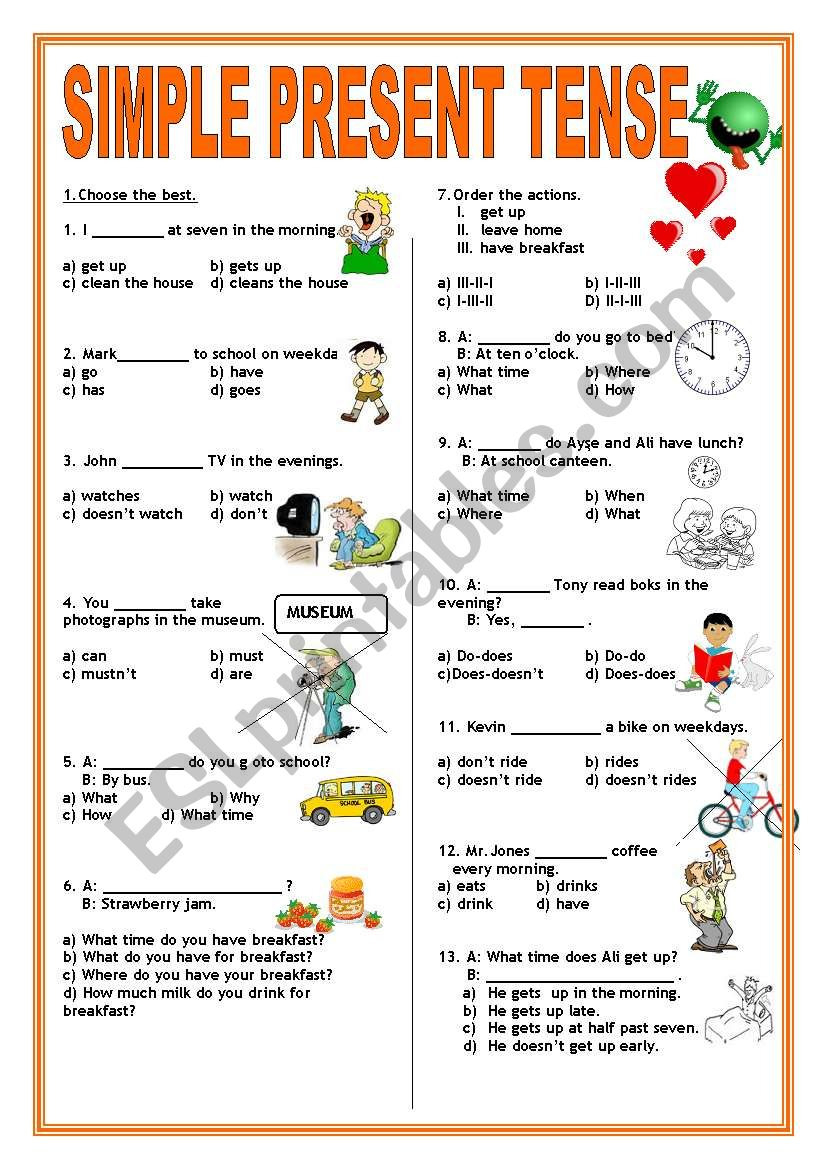
Mastering the Basics: The Indispensable Role of Present Simple Worksheets
The journey of mastering any new language begins with its foundational elements, and in English, few are as crucial as the Present Simple tense. It’s the bedrock upon which more complex grammatical structures are built, essential for expressing daily routines, universal truths, facts, and scheduled events. While theoretical explanations are vital, true understanding and fluency are forged through consistent practice. This is where well-designed Present Simple worksheets emerge as an indispensable tool for both educators and self-learners.
This comprehensive article will delve into the profound impact of Present Simple worksheets, exploring their pedagogical value, diverse formats, and how they can be effectively integrated into a language learning curriculum to ensure students not only grasp but truly internalize this fundamental tense.
Understanding the Present Simple: The Foundation

Before we dissect the role of worksheets, let’s briefly revisit the core functions and forms of the Present Simple.

Uses of the Present Simple:

- Habits and Routines: Actions that happen regularly or repeatedly.

- Example: She drinks coffee every morning.
- Facts and General Truths: Statements that are universally true or widely accepted.
- Example: The sun rises in the east.

- Schedules and Timetables: Fixed events, often for public transport, movies, or school.
- Example: The train leaves at 7 PM.

- States and Feelings: Verbs that describe a state of being, emotion, or possession, rather than an action.
- Example: He loves pizza. She knows the answer.
- Instructions or Directions: Often used in imperative form, but the simple present is implied.
- Example: You turn right at the corner. (Implied instruction)



Forms of the Present Simple:
- Affirmative:
- I/You/We/They + base verb (e.g., I work, They play)
- He/She/It + base verb + -s/-es (e.g., He works, She plays, It goes)
- Negative:
- I/You/We/They + do not (don’t) + base verb (e.g., I don’t work)
- He/She/It + does not (doesn’t) + base verb (e.g., He doesn’t work)
- Interrogative (Questions):
- Do + I/you/we/they + base verb? (e.g., Do you work?)
- Does + he/she/it + base verb? (e.g., Does he work?)
The simplicity of its name often belies the nuanced application of this tense, making targeted practice through worksheets absolutely crucial.
Why Are Present Simple Worksheets Indispensable?
Present Simple worksheets serve multiple critical functions in the language acquisition process:
- Reinforcement of Rules: After a teacher explains the rules, worksheets provide immediate opportunities to apply them. This active engagement solidifies theoretical knowledge. Repetitive exercises, while seemingly mundane, are powerful for embedding grammatical patterns into long-term memory.
- Practice Across All Forms: A good worksheet will guide students through affirmative, negative, and interrogative sentences, ensuring they can confidently construct each type. This multi-faceted practice is key to comprehensive understanding.
- Identification and Correction of Errors: Worksheets allow students to make mistakes in a low-stakes environment. Identifying their own errors, or having them corrected by a teacher, is a powerful learning mechanism. Common pitfalls, such as forgetting the ‘-s’ for the third person singular or misusing ‘do/does’, can be specifically targeted.
- Vocabulary Expansion: Many worksheets embed new vocabulary within the sentences, offering contextual learning. Students encounter new words while simultaneously practicing grammar, enhancing their overall linguistic repertoire.
- Development of Sentence Structure: By manipulating words to form correct sentences, students instinctively develop a better understanding of English sentence order, subject-verb agreement, and the placement of adverbs of frequency.
- Independent Learning: Worksheets are excellent tools for self-study. With an answer key, learners can work at their own pace, identify areas of weakness, and track their progress without constant supervision.
- Assessment and Progress Tracking: For educators, worksheets offer a quick and effective way to gauge student comprehension. They can pinpoint common areas of difficulty for the entire class, informing future lesson planning.
Diverse Formats of Effective Present Simple Worksheets
The effectiveness of Present Simple worksheets lies in their variety. A diverse range of exercise types keeps learners engaged and addresses different learning styles.
- Fill-in-the-Blanks (Conjugation):
- Example: She _____ (go) to school every day. (Answer: goes)
- These are fundamental for practicing verb conjugation, especially the ‘-s/-es’ rule.
- Sentence Transformation:
- Example: Change to negative: He plays soccer. (He doesn’t play soccer.)
- Example: Change to interrogative: They live in London. (Do they live in London?)
- These exercises challenge students to manipulate sentence structures, reinforcing the use of ‘do/does’.
- Error Correction:
- Example: Find and correct the mistake: My brother like pizza. (likes)
- This type encourages critical thinking and attention to detail, helping students internalize correct forms by identifying incorrect ones.
- Matching Exercises:
- Match the subject with the correct verb form: I / play, He / plays
- Useful for beginners to understand subject-verb agreement.
- Sentence Completion (Contextual):
- Example: Every morning, I wake up at 7 AM, then I _____ (eat) breakfast.
- Requires students to choose the correct verb and tense based on the context of a short paragraph or dialogue.
- Short Passage Comprehension with Questions:
- A short text describing someone’s routine or a factual topic, followed by comprehension questions that require Present Simple answers.
- Example: Read about Sarah’s day. What time does she wake up?
- Combines reading comprehension with grammatical practice.
- "True or False" Statements:
- Students read statements about a provided text or general knowledge and decide if they are true or false, often needing to correct the false ones using the Present Simple.
- Picture-Based Activities:
- Students describe what people are doing in pictures using the Present Simple, or create sentences based on visual cues. Excellent for visual learners and sparking creativity.
- Writing Prompts (Guided):
- Example: Write about your typical weekend using the Present Simple.
- Encourages freer production of language while still focusing on the target tense.
Designing and Selecting Effective Present Simple Worksheets
The quality of a worksheet significantly impacts its learning potential. When creating or choosing Present Simple worksheets, consider the following:
- Clear Instructions: Ambiguous instructions lead to frustration. Ensure students know exactly what is expected of them.
- Gradual Difficulty (Scaffolding): Start with simpler exercises (e.g., simple conjugation) and gradually introduce more complex tasks (e.g., error correction, longer contextual passages).
- Variety of Exercise Types: As discussed, mixing exercise formats keeps students engaged and addresses different aspects of the tense.
- Relatable Contexts and Topics: Worksheets that use real-world scenarios (daily routines, hobbies, facts about the world) are more engaging and make the grammar feel more relevant.
- Inclusion of Answer Keys: Essential for self-correction and independent learning. For classroom use, answer keys facilitate peer-checking.
- Visual Appeal: Well-organized layouts, clear fonts, and appropriate graphics can make worksheets less daunting and more inviting.
- Focus on Common Errors: Identify typical mistakes students make with the Present Simple and design exercises that specifically target these areas.
- Opportunities for Personalization: Some worksheets can include prompts that allow students to write about themselves, making the activity more meaningful.
Integrating Worksheets into Lesson Plans
Worksheets are not isolated activities; they are integral components of a well-rounded lesson.
- Warm-up: A quick fill-in-the-blanks worksheet can review the tense before introducing new material.
- Guided Practice: After explaining a new rule, work through a worksheet together as a class, clarifying doubts as they arise.
- Independent Practice: Assign worksheets for students to complete individually in class, allowing the teacher to monitor progress and provide one-on-one support.
- Homework: Reinforce learning outside the classroom, providing continuous exposure and practice.
- Assessment: Use worksheets as formative assessments to check understanding before moving on to new topics.
- Group or Pair Work: Turn worksheets into collaborative activities where students discuss answers, fostering peer learning and communication.
Beyond the Worksheet: Complementary Activities
While Present Simple worksheets are powerful, they are most effective when complemented by other learning activities.
- Speaking Practice: Encourage students to describe their daily routines, talk about their families, or discuss general facts using the Present Simple. Role-playing scenarios can also be effective.
- Writing Tasks: Assign short paragraphs or diary entries where students must consistently use the Present Simple.
- Games: Incorporate grammar games that involve Present Simple conjugation or sentence formation.
- Real-Life Observation: Have students listen for and identify Present Simple sentences in songs, movies, or everyday conversations.
- Technology Integration: Utilize online interactive quizzes, grammar apps, or digital Present Simple worksheets that offer immediate feedback.
Conclusion
The Present Simple tense is the bedrock of English communication, and its mastery is non-negotiable for any aspiring English speaker. Present Simple worksheets are far more than just paper and ink; they are dynamic tools that provide structured practice, reinforce learning, allow for error correction, and build confidence. By offering a diverse range of exercises and being thoughtfully integrated into a comprehensive curriculum, these worksheets empower learners to internalize the rules, apply them accurately, and ultimately, communicate effectively. For educators and learners alike, investing time in creating and utilizing high-quality Present Simple worksheets is an investment in linguistic fluency and a solid foundation for future language success.
